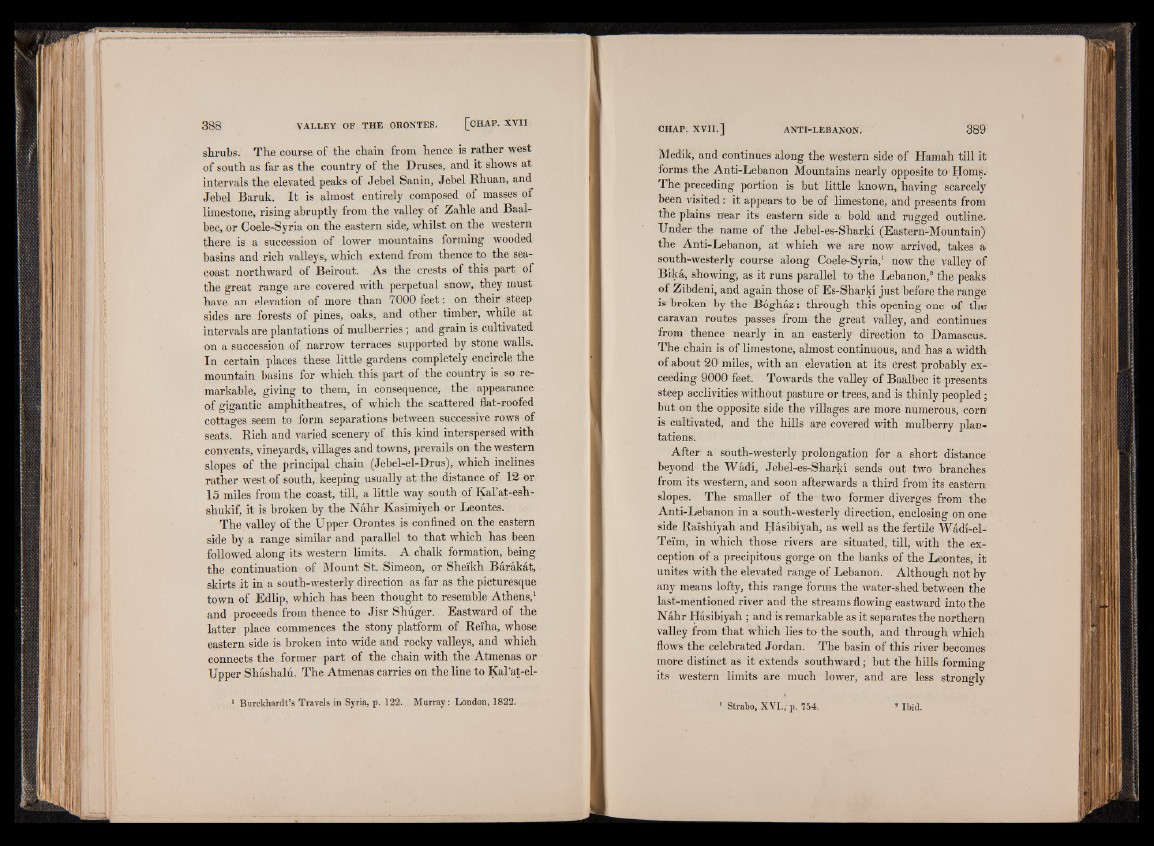
shrubs. The course of the chain from hence is rather west
of south as far as the country of the Druses, and it shows at
intervals the elevated peaks of Jebel Sanin, Jebel Rhuan, and
Jebel Baruk. It is almost entirely composed of masses of
limestone, rising abruptly from the valley of Zahle and Baal-
bec, or Coele-Syria on the eastern side, whilst on the western
there is a succession of lower mountains forming wooded
basins and rich valleys, which extend from thence to the sea-
coast northward of Beirout. As the crests of this part of
the great range are covered with perpetual snow, they must
have an elevation of more than 7000 feet: on their steep
sides are forests of pines,, oaks, and other timber, while at
intervals are plantations of mulberries| and grain is cultivated
on a succession of narrow terraces supported by stone walls.
In certain places these little gardens completely encircle the
mountain basins for which this part of the country is so remarkable,
giving to them, in consequence, the appearance
of gigantic amphitheatres, of which the scattered flat-roofed
cottages seem to form separations between successive rows of
seats. Rich and varied scenery of this kind interspersed with
convents, vineyards, villages and towns, prevails on the western
slopes of the principal chain (Jebel-el-Drus), which inclines
rather west of south, keeping usually at the distance of 12 or
15 miles from the coast, till, a little way south of Kal’at-esh-
shukif, it is broken by the Nahr Kasimiyeh or Leontes.
The valley of the Upper Orontes is confined on the eastern
side by a range similar and parallel to that which has been
followed along its western limits. A chalk formation, being
the continuation of Mount St. Simeon, or Sheikh Barakat,
skirts it in a south-westerly direction as far as the picturesque
town of Edlip, which has been thought to resemble Athens,1
and proceeds from thence to Jisr Shuger. Eastward of the
latter place commences the stony platform of Reiha, whose
eastern side is broken into wide and rocky valleys, and which
connects the former part of the chain with the Atmenas or
Upper Shashalu. The Atmenas carries on the line to Kal’at-el-
1 Burckhardt’s Travels in Syria, p. 122. Murray : London, 1822.
Medik, and continues along the western side of Hamah till it
forms the Anti-Lebanon Mountains nearly opposite to Homs.'
The preceding portion is but little known, having scarcely
been visited: it appears to be of limestone, and presents from
the plains near its eastern side a bold and rugged outline^
Under the name of the Jebel-es-Sharki (Eastern-Mountain)
the Anti-Lebanon, at which we are now arrived, takes a
south-westerly course along Coele-Syria,1 now the' valley of
Bika, showing, as it runs parallel to the Lebanon,8 the peaks
of Zibdeni, and again those of Es-Sharki just before the range
is broken by the Boghaz: through this opening one of the
caravan routes passes from the great valley, and continues
from thence nearly in an easterly direction to Damascus.
The chain is of limestone, almost continuous, and has a width
of about 20: miles, with an elevation at its crest probably exceeding
9000 feet. Towards the valley of Baalbec it presents
steep acclivities without pasture or trees, and is thinly peopled;
but on the opposite side the villages are more numerous, corn
is cultivated, and the hills are covered with mulberry plantations.
After a south-westerly prolongation for a short distance
beyond the Wadi, Jebel-es-Sharki sends out two branches
from its western, and soon afterwards a third from its eastern
slopes. The smaller of the-two former diverges from the
Anti-Lebanon in a south-westerly direction, enclosing on one
side Raishiyah and Hasibiyali, as Well as the fertile Wadi-el-
Tei'm, in which those rivers are situated, till, with the exception
of a precipitous gorge on the banks of the Leontes, it
unites with the elevated range of Lebanon. Although not by
any means lofty, this range forms the water-shed between the
last-mentioned river and the streams flowing eastward into the
Nahr Hasibiyah ; and is remarkable as it separates the northern
valley from that which lies to the south, and through which
flows the celebrated Jordan. The basin of this river becomes
more distinct as it extends southward; but the hills forming
its western limits are much lower, and are less strongly
1 Strabo, XVI., p. '754. * Ibid.